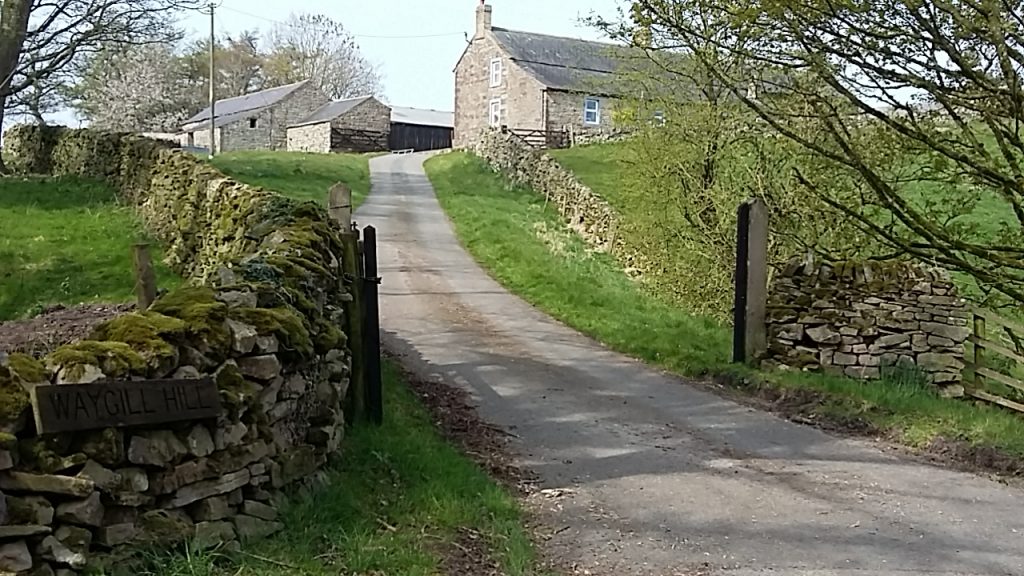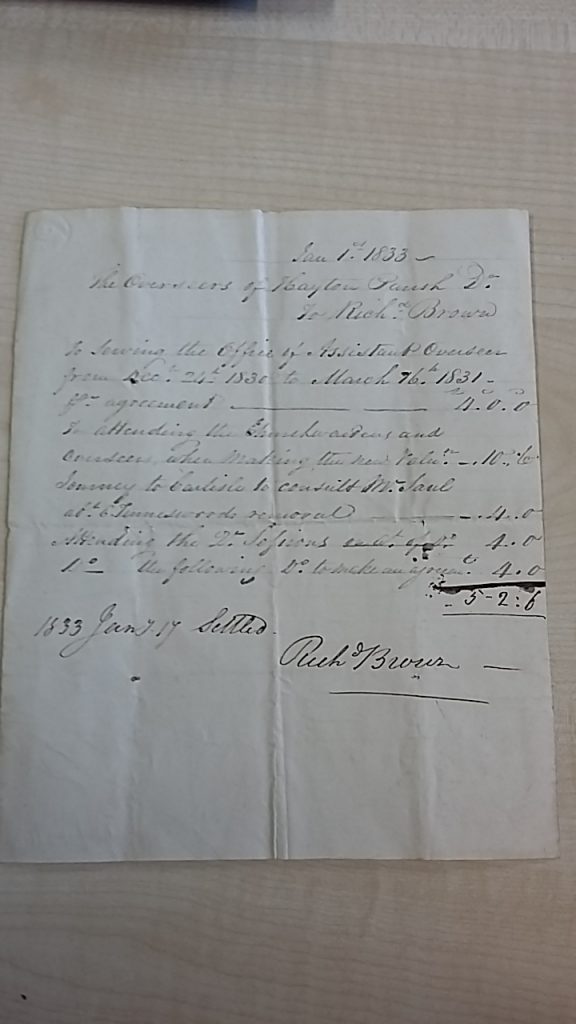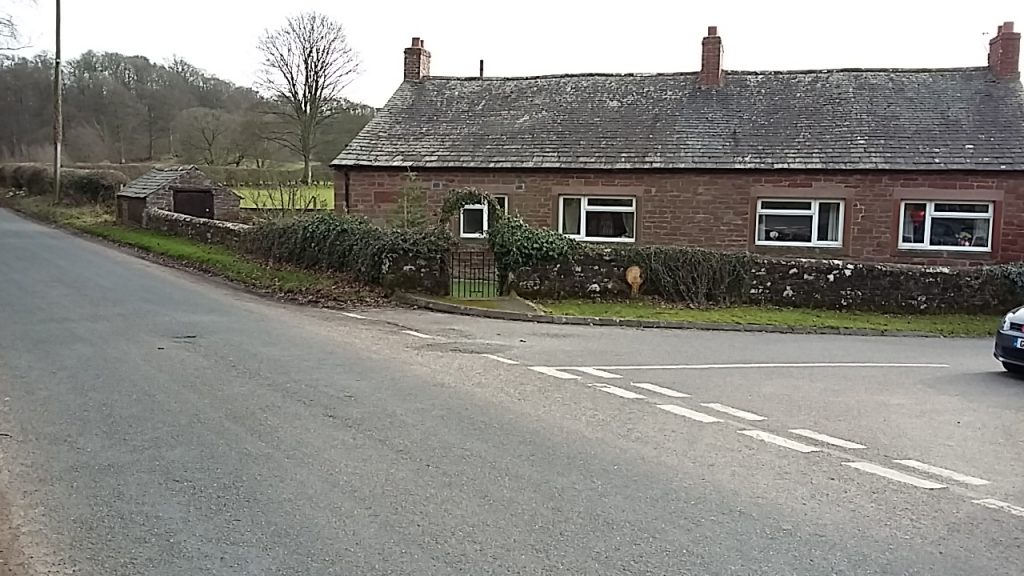
Waygill Hill was a farm near Talkin Village. In the eighteenth and nineteenth centuries it was owned by the Tinniswood family; one of the principal families in the area. Other branches of the Tinniswood family lived at Cumcatch and Boothby.
Wills going back to the early 1700s suggest they had a comfortable income. The Reverend Whitehead writes about the Tinniswoods of Waygill Hill in 1879 alluding to their importance in the area and the subsequent loss of the farm.[1]
Waygill Hill passed into the custody of Robert Tinniswood (1752-1820) and his wife Dorothy Bell (1759-1829) although the exact date is unknown. They appeared to be prospering, owning other farms in the area. Subsequently property sale announcements begin to appear for the farms in the local newspapers. Far Tarn End Estate was put up for sale in 1814. [2] Ash Tree Farm and Waygill Hill (which had already been re-mortgaged in 1809) followed. [3] When Robert Tinniswood died in 1820 there was very little left. [4] Robert was described by the Rev Whitehead as ‘an extravagant man‘. Robert’s widow moved to nearby Brampton, possibly to live with two of her children Jane and Elizabeth.
The first voucher referring to the Tinniswoods and settled by Richard Brown is dated January 1833. [5] It relates to Robert and Dorothy’s oldest son John Tinniswood (1772-1831) who probably expected to succeed his father at the farm. One of the items on the voucher refers to
‘a journey to Carlisle to consult Mr Saul [solicitor] about E Tinniswood 4s.0.’
A report in the Carlisle Patriot provides the probable circumstances which the voucher relates to. [6] Kirkbampton Parish faced with the financial care of Elizabeth Tinniswood’s unborn child were seeking her removal to Hayton where they felt her settlement lay. Witnesses were called, amongst them Elizabeth’s mother, now called Mrs Thompson. She explained that she married John Tinniswood at Gretna but he soon left her. She gave birth to Elizabeth in Dumfries and took her to John Tinniswood in Hayton. As her marriage had no legal standing, she was encouraged by a magistrate to pursue John for money. An 1816 bastardly order for St Mary’s Within, Carlisle, named John Tinniswood as the father of the child of Elizabeth Calden. [7] Mrs Thompson said that John Tinniswood subsequently married at least twice more at Gretna but on each occasion left his wife.
Cross-border marriages were common at this time due to the difference in English and Scottish marriage laws. Brampton and Hayton were foremost amongst English border settlements taking advantage of irregular marriages on the Scottish side of the border. It was a booming business.
Young Elizabeth Tinniswood was taken to the workhouse in Hayton where she lived until the age of 11. She explained that she left the workhouse and went into service. For two years she had been at Elizabeth Proud’s Hardbank Mill working, as she said, for ‘her meat and clothes‘.
John Tinniswood died in 1831. There are no records of his marriages or any other children he may have had. No decision was reached in Elizabeth’s case. It was due to be heard again at another session. This may not have happened. Elizabeth Tinniswood gave birth to a daughter named Eliza on 30 July 1832 in Hayton. She was baptised privately but died 2 August 1832. [8]

PR102/114/4, Hayton Overseers’ Vouchers, 17 January 1833.
Robert Tinniswood (1773-1861), the second son, was an innkeeper at Low Gelt Bridge with his wife Christina Brown. In January 1817 they were faced with the prospect of bankruptcy. His effects and estate were assigned to Joseph Cox and Thomas Halliburton for the benefit of Tinniswood’s creditors. [9] The property itself was not put up for sale but all the goods in it were. In May of the same year his father was attempting to sell Waygill Hill.
A voucher dated 1821 ‘to buy clothing for ‘Tinniswood Child at 2s’ may refer to Robert’s children.[10] Robert, now working as an agricultural labourer, and his family remained at Bye Gelt.
George Tinniswood (1798-1859) was the fourth born and third surviving son. He never married. He worked on the Brackenthwaite Estate at Cumrew.[11] Like his two brothers, he was an agricultural labourer. By this time their parents’ farm was owned by Mr Graham of Edmund Castle.
Margaret was the eldest daughter born in 1780 but nothing can confidently be attributed to her life or her sister Mary. Mary (1782-1818) died 2 years before her father. The Carlisle Patriot describes her as dying after a lingering illness.[12]
Another daughter Dorothy (1785-1858) married first Thomas Simpson Wills (1774-1809) then after his death the Reverend John Leech (1793-1864) on 9 August 1820. They moved shortly after to Berwick upon Tweed. Her son, Edmond Wills, appears in another voucher.[13]
‘Rec’d Apr 10 1833 of ‘David Watt [Parish Clerk] the sum of £1.15s for Henry Browns House due to Edmond Wills for whose use received the same E Tinniswood’.
It has been assumed this is Elizabeth Tinniswood, Dorothy’s sister. Edmond Wills (1808-1856) subsequently entered the clergy living in Barkstone, Lincolnshire.
The two unmarried sisters, Elizabeth Tinniswood (1787-1870) and Jane (1789-1863) were left £20 by their mother in her will of 1831. Around this time they began trading as confectioners and grocers in Brampton [14]. They were still trading at Front Street when Jane died in 1863. [15] She left her estate of less than £200 to her sister Elizabeth. [16] When Jane died they had been trading at the same place Front Street, Brampton, for around 35 years. Elizabeth left her estate of under £100 to her surviving brother William (1794-1878). William, having moved to Leeds, Yorkshire, was an excise officer.[17]
Thomas (1791-1851), the other brother, had married Betsy Watson and had a large family. He was first surveyor of taxes for Eskdale Ward which included Brampton and Hayton then from 1820 Berwick upon Tweed. [18] He died at 31 King Street, Carlisle in 1851. [19]
Waygill Hill still stands near Talkin village today. The Tinniswood sons perhaps hoped for a future on their father’s farm but it was not to be. An epitaph to their father was placed in Hayton Church. [20] although I couldn’t find it in April 2019.
‘Farewell vain world, I’ve seen enough of thee’ And now am careless what thou say’st of me;. Thy smiles I court not, nor thy frowns I fear, My cares are past, my head lies quiet here. What faults you view in me take care to shun, and look at home; enough there’s to be done’

Sources
[1] Carlisle Patriot, 12 December 1879
[2] Carlisle Journal, 16 July 1814
[3] Carlisle Patriot, 11 December 1829
[4] Cumbria Archives, PROB1826/AB(38) Administration Bond, Robert Tinniswood
[5] Cumbria Archives, PR102/114/4, Hayton Overseers’ Vouchers, 1 January 1833
[6] Carlisle Patriot, 7 July 1832
[7] Cumbria Archives, CQ 5/7 Carlisle, Quarter Sessions, Bastardly Recognitions, Midsummer 1816.
[8] Cumbria Archives, PR 102/8 Hayton, St Mary Magdalene Parish Burial Register 1811-1879
[9] Carlisle Patriot, 18 January 1817
[10] Cumbria Archives, PR102/110/2, Hayton Overseers’ Vouchers, December 19 1821
[11] Carlisle Journal, 25 March 1859
[12] Carlisle Patriot, 7 February 1818
[13] Cumbria Archives, PR102/114/8, Hayton Overseers’ Vouchers, 10 April 1833
[14] Parsons, W. M. & White, W.C., History, Directory and Gazetteer of the Counties of Cumberland and Westmorland (Pigot & Co., 1829)
[15] Cumbria Archives, PROB/1863/W125a, Will of Jane Tinniswood
[16] Cumbria Archives, PROB/1870/W653a, Will of Elizabeth Tinniswood
[17] www.findmypast.co.uk accessed 1 June 2019
[18] Carlisle Patriot, 19 February 1820
[19] Carlisle Journal, 28 March 1831
[20] Cumbria Archives PR 60/5
Various reference to the Tinniswoods in Catalogue of the Howard Family papers related to Cumberland. Durham University Library accessed at www.http://endure.dur.ac.uk:8080/fedora/get/UkDhU:EADCatalogue.0154/PDF accessed 1 June 2019
2 thoughts on “Tinniswoods of Waygill Hill, Talkin, Hayton Parish”